Comparing Simple Moving Average vs. Exponential Moving Average

Moving averages are tools frequently used in trading strategies. When used correctly and with knowledge, they can be of great advantage. This article covers the difference between EMA and SMA, calculating Exponential Moving Average, setting EMA for trading, and using EMA-based strategies.
What is the Simple Moving Average?
The Simple Moving Average (SMA) shows the average of a selected range of prices. It is calculated by adding the most recent prices and dividing the resulting number by the number of periods in the calculation average.
What is the Exponential Moving Average (EMA)?
While the SMA gives equal weight to all values, the Exponential Moving Average (EMA) provides a higher weighting to recent prices. Because the EMA gives more weight to current data than older data, it is more reactive to the latest price changes than the SMA. For that reason, some traders prefer this type of moving average.
The other two types of moving average are Smoothed Weighted and Linear Weighted. The main difference between the types of moving average lies in the sensitivity to changes in the data used in their calculation.
Simple Vs. Exponential Moving Average
Both the EMA and the SMA are technical indicators. They use past data to generate a smooth trend line for the security price. But what’s the difference between them?
The EMA places a greater weight on recent prices, whereas the SMA places equal weight on all data points; this is why the EMA line turns faster than the SMA line.
The optimal moving average to use for your analysis depends on your trading strategy. However, it is essential to note that none of the moving averages is better than the others. For example, although the EMA accurately represents recent price movements and helps identify trends quicker, it also experiences more short-term fluctuations than the SMA.
How to calculate the Exponential Moving Average (EMA)
Calculating the EMA is a little more complicated than calculating the SMA:
- Calculate the Simple Moving Average.
SMA = the sum of the closing prices for the number of periods / the number of periods
- Calculate the multiplier for the smoothing/weighting factor for the previous EMA.
Multiplier = 2 / (the number of periods + 1)
- Get the Exponential Moving Average for the current period.
EMA for the current period = (closing price - EMA for the previous period) * multiplier + EMA (previous period)
You may use the SMA as the EMA for the previous period if you are calculating the EMA for the first time.
However complex the whole thing may seem, the good news is computers calculate moving averages for us now, so you don't have to do all the math yourself.
Setting up the EMA
To apply the Exponential Moving Average to your MetaTrader 4 and MetaTrader 5 chart, choose Insert – Indicators – Trend. Then you must click the “Moving Average” button and change the MA method to Exponential.
You can also choose the period, method, and even the color of the EMA.
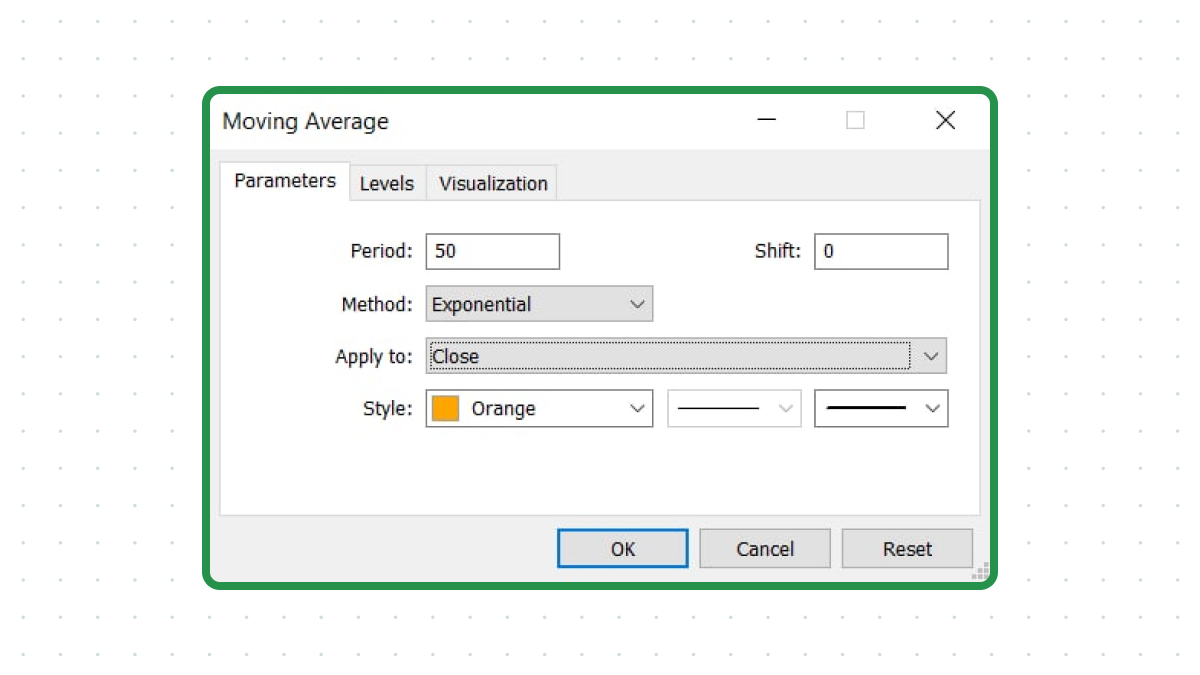
Experienced traders usually calculate EMA according to the close price.
The 8- and the 20-day EMA tend to be the most popular periods for day traders, while the 50- and the 200-day EMA are better suited for long-term investors.
Trading with the EMA
1. EMA ribbons strategy
Traders sometimes watch moving average ribbons, which plot many moving averages rather than just one moving average onto a price chart. Though seemingly complex, EMA ribbons are easy to see on charting applications and offer a simple way of visualizing the dynamic relationship between trends in the short, intermediate, and long term.
Traders and analysts rely on moving averages and ribbons to identify turning points, continuations, and overbought/oversold conditions, define support and resistance areas, and measure price trend strengths.
To construct a moving average ribbon, plot many moving averages of varying period lengths on a price chart. Common parameters include eight or more moving averages and intervals that range from a 2- to 400-period moving average. The most popular EMA ribbon consists of eight lines from the 20- to 55-period EMAs.
When all the moving averages converge into one point on the chart, the trend strength may weaken and point to a reversal. The opposite is true if the moving averages are fanning and moving apart, suggesting that prices range and that a trend is strong or strengthening.
In downtrends, shorter moving averages cross below longer moving averages. Conversely, uptrends show shorter moving averages travel above longer moving averages.
Moving average ribbons are easy to interpret. The indicators trigger buy and sell signals whenever the moving average lines all cross at one point. Traders look to buy when shorter-term moving averages cross above the longer-term moving averages from below and sell when shorter moving averages cross all other lines from above.
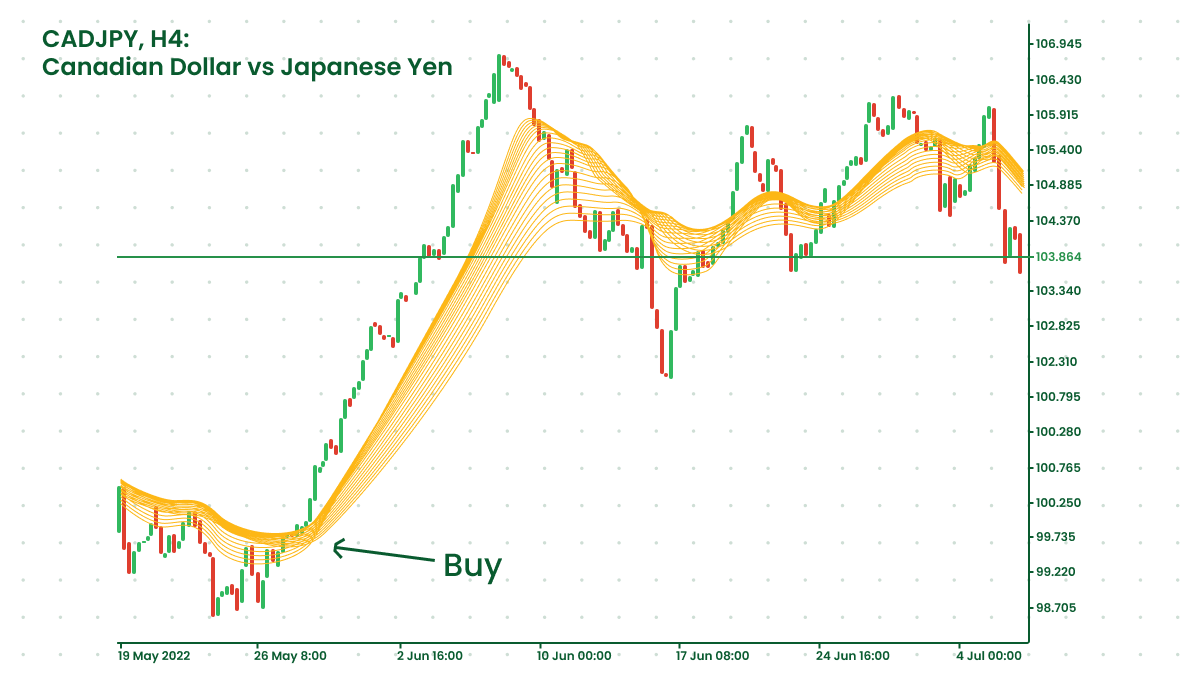
Moreover, traders use the EMA ribbon as a support and resistance level:
- If the price breaks and closes the candle below the EMA ribbon during an uptrend, it’s a sell signal.
- Conversely, if the price breaking and closing the candle above the EMA ribbon during a downtrend is a buy signal.
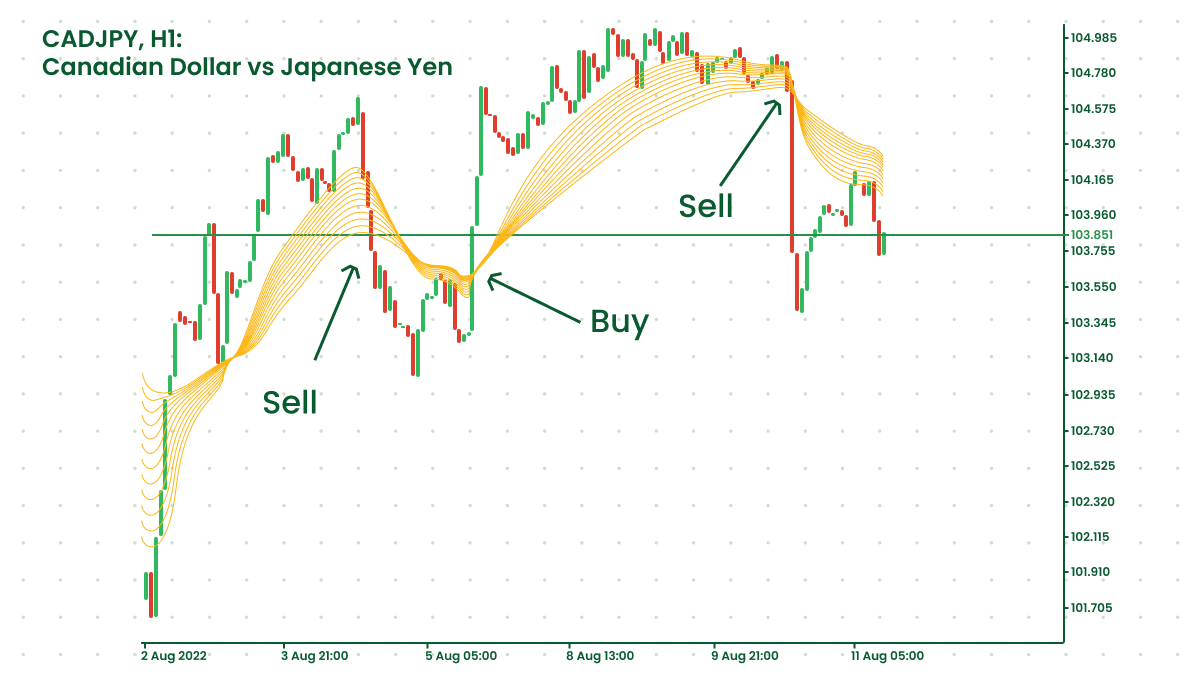
Important: For ease of analysis, keep the type of moving average consistent across the ribbon. Use only Exponential Moving Averages or Simple Moving Averages.
2. DEMA (the Double EMA strategy)
The strategy below is perfect for swing traders. We suggest you use the H1 timeframe, as it fits the strategy best: using two EMAs on lower timeframes may create lots of interrupting noise.
A strategy to open a long position:
- Wait for the short EMA to cross the long EMA to the upside.
- Wait for other confirmations (break of the critical level).
- Place your Stop Loss behind the last high or low.
- Track the direction of the moving averages.
- Close your position after the short EMA crosses the long EMA to the downside or the price reaches your target.
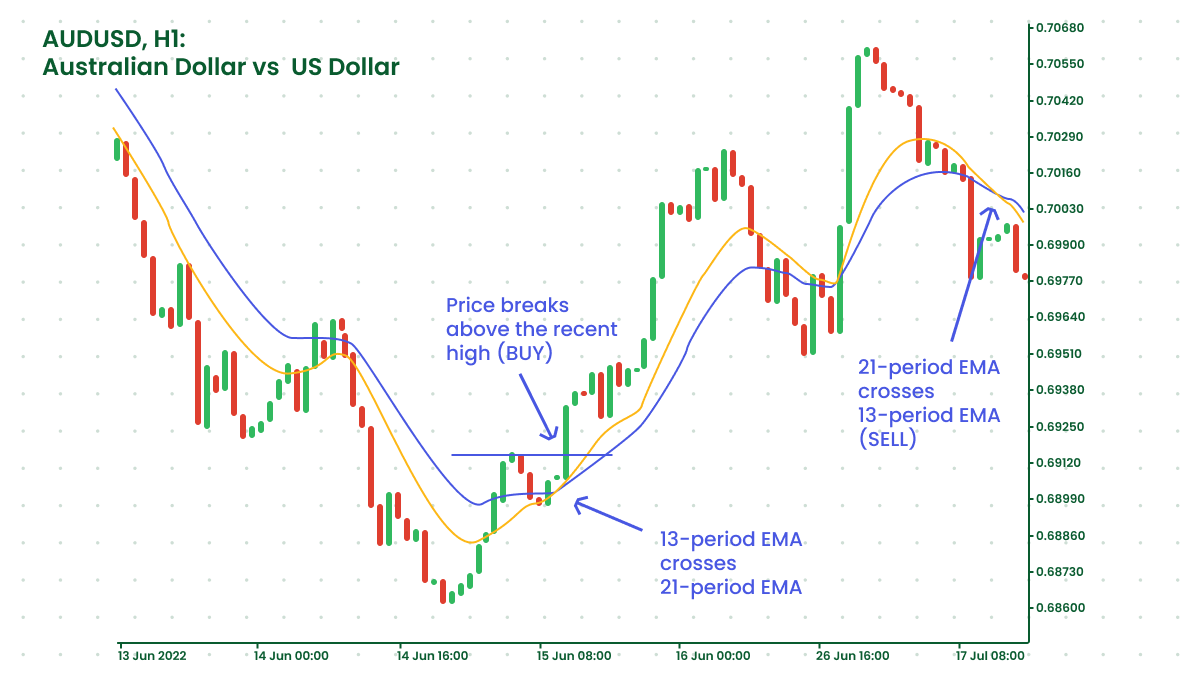
As shown in the image, brown 13-period EMA and orange 21-period EMA are applied to the H1 chart of AUDUSD on June 15. The pair started to go up when the orange line crossed the brown line to the upside. A trader enters the long position after the breakout of the recent high, which acts as a resistance level. Then they close the position as the orange EMA crosses the brown one upside down.
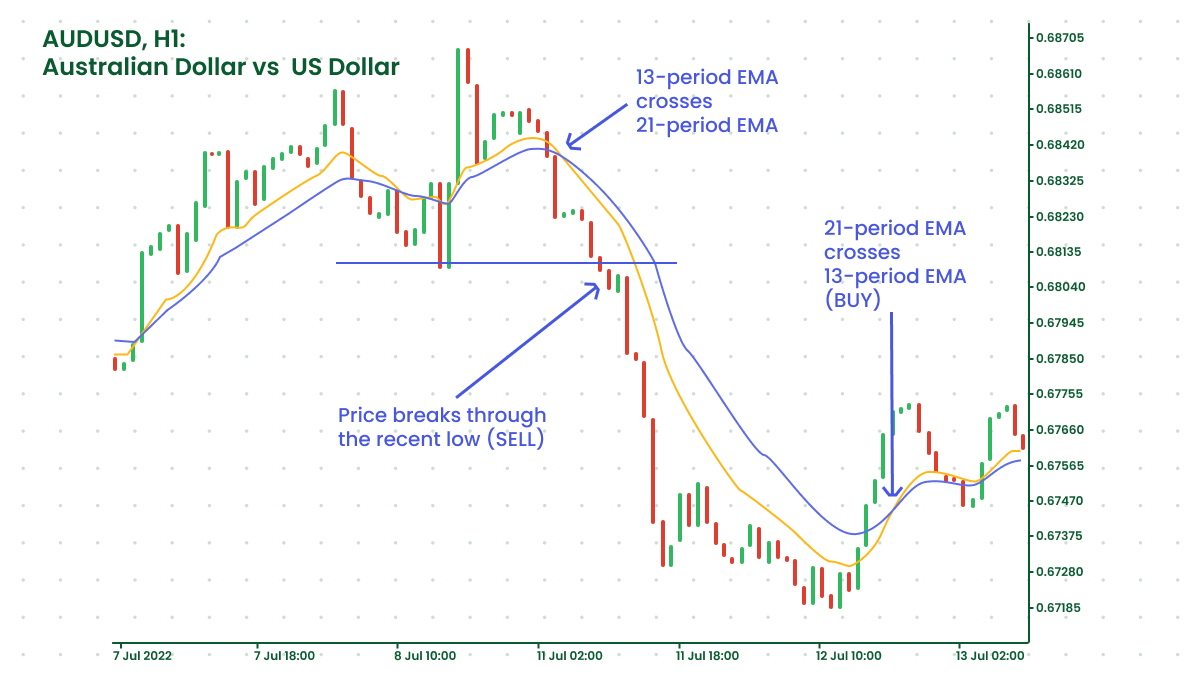
Conversely, if the orange line (short EMA) crosses the brown line (long EMA) to the downside, this may signal an opportunity to open a sell trade. You must close your position when the short EMA crosses the long EMA to the upside.
3. Using EMAs as dynamic support and resistance
Moving Averages can also indicate support and resistance areas. A rising EMA tends to support the price action, while a falling EMA tends to provide resistance to price action. A trader should open a buy trade when the price is near the rising EMA and sell when the price is near the falling EMA. For this strategy, 25 EMA on H1 fits the best.
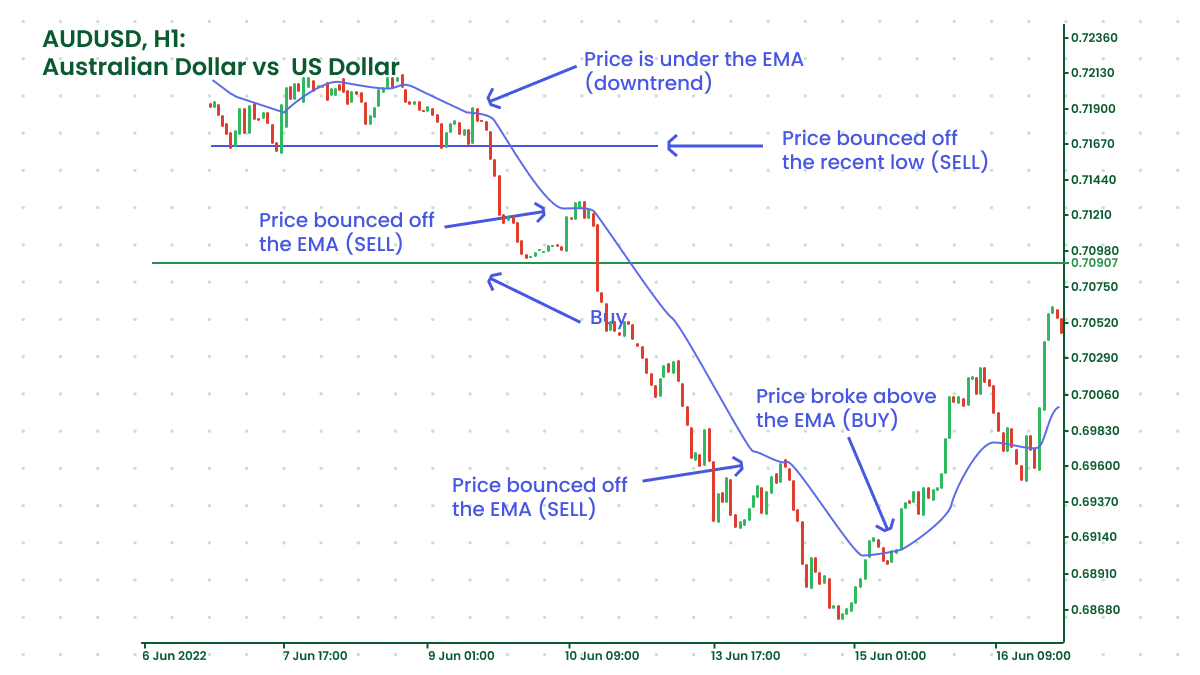
EMA vs. SMA: summary
Depending on their strategies, traders prefer different numbers and types of Moving Averages. However, EMA seems especially popular for giving more weight to recent prices, lagging less than other averages. You will find EMAs in many truly efficient trading strategies, with the EMA ribbon as one of the most valuable tools for finding entry points and stopping market reversals.




